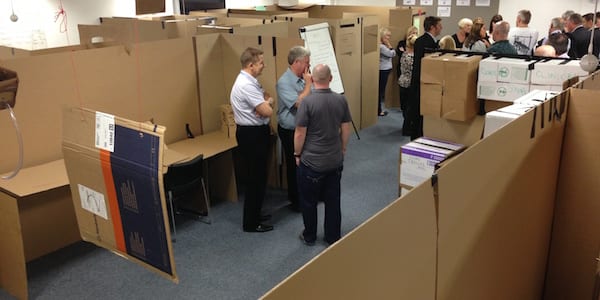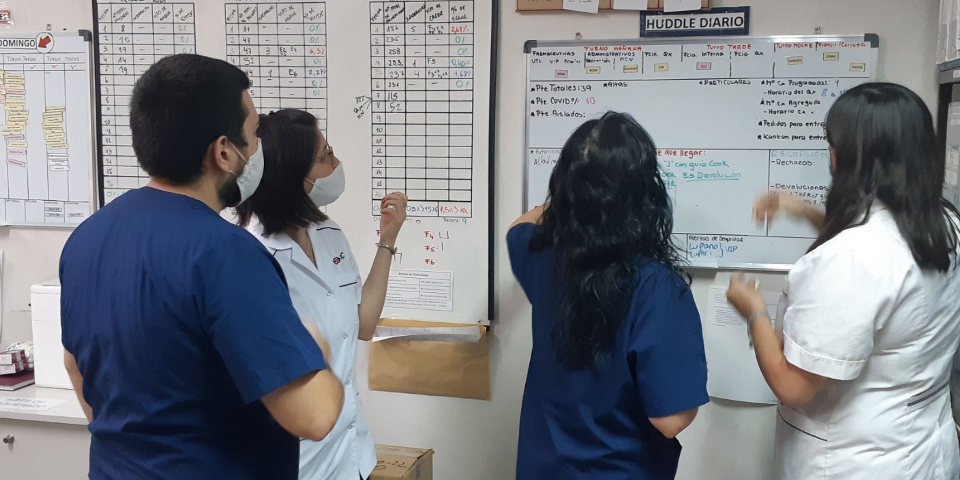
Lean healthcare: 3P design for the hospitals of tomorrow
ARTICLE - Improving healthcare architecture means truly meeting patient requirements. This article reflects on the power of 3P design and looks at an implementation in the North East of England.
Words: Gary Prior, Lean Programme & Implementation Manager, North East Transformation System hosted at Gateshead Health NHS Foundation Trust
Here’s an interesting figure: since 2012-2013 the NHS has increased its reported levels of capital investment by 4.5%. Is this money being used effectively? My personal view is that we are wasting huge amounts of money designing over-sized hospitals and healthcare facilities.
Just like product design, which can account for up to 80% of the final costs, the design of a hospital can lock in significant costs too. Poor visual management, which often isn’t easily identified from blueprints, can have an immediate impact on staffing levels - especially in high acuity settings.
In one case I’m familiar with, staff were forced to create workarounds like placing baby monitors into rooms they couldn’t easily see into. They bought a number of baby monitors and placed one in each room, turned them on and went back to the nursing station only to discover another problem. The monitors were all from the same brand and operated on the same set of limited channels. Staff had to go out again and buy a number of monitors from four different brands. That was their solution because nobody was going to change a newly opened children’s unit so soon.
Imagine something like this happening in a brand new multi-million pound unit; it shouldn’t but it did. What sort of impact would this have on patient safety?
THE ISSUE

Healthcare architecture can be very complicated, particularly when it comes to extracting a brief describing the requirements that need to be accommodated into the future design. Healthcare organizations can use a mix of lean and innovation to obtain a far more detailed brief, which will allow them to design in improved aspects of safety, quality, flow and value for the patient. Most importantly, they can prevent silly mistakes from happening that front-line staff and patients will have to put up with for the foreseeable future. This can include increased infection control risks, ergonomically poor pathways and issues like one toilet between six patients recovering from a colonoscopy, a procedure that is most likely going to result in a patient needing to use a toilet.
Imagine a busy day with four or five treatment rooms feeding into one recovery area; queues for the toilet build up fast.
This is where 3P (Production Preparation Process) can help alleviate the problem. You see, when it comes to designing new healthcare buildings too often not all the stakeholders get a voice in the design process. This can result in substandard design, as well as expensive capital development projects which don’t truly meet the need of the patient or staff. The staff must create shortcuts and the patients very often have to put up with it unknowingly.
THE SOLUTION
Why waste money, shouldn’t we feel obliged to ensure that every pound is used as best it can be? So why not work with the front-line and support staff and lead them through a 3P activity? 3P is an approach that aims to meet customer requirements with the least possible waste. In healthcare it can be used to fully understand what is important to both staff and patients in order to create a seamless experience for them. This is achieved through a series of design iterations including vision boards, bubble diagrams and full-scale mock-ups.
To understand the patient needs we need to involve them, too. As scary as this idea might sound to some, 3P offers a platform for patient involvement and really allows you to focus your creative capacity on what matters most to patients. When you combine this with the collective wisdom of front-line staff and really listen to what works and what doesn’t you’re respecting them. You’re also allowing them to hear what matters to the patients and to co-design solutions together. You’re not imposing a new facility on them, which at most involved a few consultants sitting around in a focus group, but you are turning the process on its head and taking into account what really matters.
THE POWER OF PATIENT INVOLVEMENT
Why involve patients in the co-design process? This video explains it.
With 3P you are doing more than just listening. You are unleashing the human creativity that is found in everybody. That has been a big challenge as people can be a little apprehensive to begin with. Historically mistakes may have been stigmatized and as a result people behave as can be expected. Yet with a little encouragement they begin to open up and fully participate. It’s not long before they are making prototypes that allow them to see things for real. They quickly become fully involved in the opportunity that has been presented to them.
A MINI CASE STUDY

The first 3P experiment took place in an endoscopy unit at Gateshead Health NHS Foundation Trust. It was designed in the 1980s and had evolved over time. New legislation for bowel cancer screening was increasing demand. Some of the participants had been involved in kaizen/RPIW type events but the majority had not so the challenge was there to be overcome. This was achieved by placing a premium on the practical application of lean through coaching and effective challenging.
The group began by analyzing ways to eliminate wasteful processes in the current patient pathway. They then proposed alternatives and translated these future state options into bubble diagrams. This allowed them to create and explore many different 2D plans. It was during this time that they were able to test out the seven flows of healthcare. It was then time to dive a bit deeper into the design experience. This involved creating and testing different life size patient pods and treatment rooms. These pods aimed to bring care to the patient. Processes such as consent, pre-optimization and changing would take place in these pods. This had the benefit of eliminating most of the walking for the patients. The teams carried out further tests in these rooms and took this learning forward to a final round of design iterations via rapid prototyping where more improvements were made.

The final design reduced the patient walking distance by 26%. It reduced queues from five to one and most importantly the team were able to go back to their current set-up and apply some of the learning straight away. As I was carrying out observations at the gemba, and sketching some spaghetti diagrams, I noticed that following every procedure (currently over 9,800 per year), a healthcare assistant or very often a nurse would come out of the room and make a return trip of 74 meters to the decontamination area in order to return a dirty scope for processing and a new scope back for the next patient.
I challenged one of the sub teams in the event to explore this issue and explained the role of a water spider to them. They quickly caught on and devised a system of their own with some further coaching and PDSA cycles. This and other set up reduction activity reduced the procedure room set up time by three minutes per cycle. More importantly, it was easily replicated across all four treatment rooms with the added bonus that more lists began to finish on time. This was good for both staff and patients, particularly patients who didn’t have to wait very long.
IS THIS A PEOPLE PROBLEM OR A SYSTEM PROBLEM?
Hospitals and architects in the UK are encouraged to use health building note guidelines to help inform the design of these buildings. They often do this and the end result can be lacking in terms of privacy and dignity and in all likelihood is simply a bigger version of what they’ve already got. In this case, I would say it is clearly a system problem: imposed recommendations that are far behind current front-line models for best practice can only result in substandard outputs. Regrettably this is the case in many endoscopy units around the country.
To tackle the situation, in the past two years the NHS has invested millions in fit for purpose endoscopy units with “in-built” patient privacy and dignity issues.
Some have a distinct lack of separate clean and dirty routes, thus increasing infection control risks. What about instances of in-patients, who may be suffering from lots of different conditions, being wheeled in on trollies past out-patients who are trying to get in and out as quick as possible? Hospitals are already scary places for many people – we don’t need to make matters worse.
CONCLUSION
How many hospitals are so forward thinking that they offer their staff the opportunity to co-design the area they will work in? There are a growing number of examples in North America and some pockets of activity in Europe but this approach is still in its infancy, particularly in the NHS. Consider that in a relatively small unit 857 square meters in size on a typical shift some nurses were walking 7.6 kilometres; that’s around 91 minutes walking time per day. You can extrapolate this upwards to get an idea of what is happening in larger hospital units.
Why are we spending millions of pounds building facilities with inherent flaws, when these could be minimized during the design stage by using feedback from patients and staff? Too often designers, architects and even healthcare professionals make costly assumptions. This leads to less than adequate health provisions for the patients. When used correctly and aligned effectively with an organization’s estates strategy, 3P offers a way to minimize this performance gap.
THE AUTHOR

Gary Prior is Lean Design of Space Programme Manager for the NHS’s North East Transformation System (NETS). NETS is an improvement collaborative who help other NHS organisations on their quality improvement journey. The NETS lean healthcare design work was part of the Health Foundation’s Shared Purpose Programme. The Health Foundation is an independent charity working to continuously improve the quality of healthcare in the UK. Connect with Gary on Twitter @GaryPrior or on LinkedIn.
Read more


FICTION – In the second and final part of this story, the main characters discuss in front of a board. If you regularly use visual management, their conversation will resonate with you.


CASE STUDY – This hospital in Argentina has leveraged the power of Lean Thinking to greatly enhance patient care, even in the pandemic, and receive internationally renowned accreditations.


FEATURE – Reflecting on the transformations he has supported, the author provides a few recommendations on how to get products to market faster.


INTERVIEW – A specialist in control solutions for air-conditioning, refrigeration and heating, Carel Industries first applied lean to R&D a decade ago, when few companies did. We asked them how their journey unfolded.

